Venice, Italy: Staying on Lido Island, Exploring Piazza San Marco and Riding the Gondola on Venice Island, and Watching Glass Artisans in Action on Murano Island Glass Factories
 |
| Piazza San Marco (St. Mark's Square) from Venetian Lagoon |
We arrive late in the night at Venezia Santa Lucia railway station from Zürich, Switzerland via Milan, Italy on Trenitalia Frecciabianca high-speed train and take a bus ("waterbus" of course in Venice) to Lido island to check into our B&B. The next day we take a land bus to the water bus stop and return to the Grand Canal of Venice island to do the mandatory Venetian tourism activities of a Gondola ride and visiting Piazza San Marco. We then take another waterbus to Murano island to check out glass artisans in action at world famous glass factories before returning to Venice. Back at Venezia Santa Lucia railway station, we take a Trenitalia Frecciarossa fast train to our next destination of Rome. Here is a quick photo story.
Watch: Venice - Staying in Lido, Gondola Ride and Piazza San Marco in Venice and Glass Factories in Murano
Venice Santa Lucia Railway Station
Our Trenitalia Frecciabianca high-speed train from Milano Centrale pulls into Stazione di Venezia Santa Lucia slightly after 10:30 PM in the night. The Venice Santa Lucia Train Station is a majestic gateway to the City of Canals and is more than just a transportation hub. Stepping out of its grand 1940s facade adorned with mosaic patterns and towering windows, we are greeted by the shimmering embrace of the Grand Canal lapping right against the station's foundations.
 |
| Stazione di Venezia Santa Lucia. The Chiesa di San Simeon Piccolo is across the Grand Canal. |
We immediately see the Chiesa di San Simeon Piccolo across the Grand Canal. This elegant neoclassical church built between 1718 and 1738 by architect Giovanni Antonio Scalfarotto is dedicated to Saints Simon and Jude. The church's façade is characterized by a portico of four Ionic columns supporting a triangular pediment which is decorated with a marble relief depicting the martyrdom of Saints Simon and Jude. The interior of the church is basilica-shaped with three naves divided by Corinthian columns. The apse is decorated with a mosaic depicting the Crucifixion.
Riding a Vaporetto to our B&B at Lido di Venezia
It does not take us long to learn that in Venice, words like "bus" and "taxi" default to craft that sail on water, i.e. "bus" is a waterbus and "taxi" is a watertaxi. In the far less frequent cases of buses or taxis on roads (like the "A" or "N" buses on Lido), Venetians specifically refer to them as "land buses" and "land taxis".
 |
| Ferrovia waterbus stop at Venice Santa Lucia train station |
The fully developed Venetian public water-bus mass transit system is called vaporetto (little vapor-producing craft, i.e. small steamer) which is the equivalent of a dense metro system in any other advanced city of the world. Its 19 lines and numerous waterbus stops (jetties) cover all of the main and satellite islands conveniently. Venice Santa Lucia railway station is served by the Ferrovia vaporetti stop.
The city is dark and quiet at this late hour but the Line N - Night Water Bus - is still running. We walk to the Ferrovia "B" stop and purchase tickets from the biglietteria for the N waterbus to Lido S.M.E. (Lido Santa Maria Elisabetta) on the island of Lido di Venezia.
 |
| Ferrovia water bus stop at Venice Santa Lucia train station |
Gliding through the canals of Venice, the vaporetti are more than just water buses; they are timeless icons weaving the city's watery streets into a vibrant tapestry. These sleek, black vessels, adorned with vibrant orange accents, have become synonymous with Venetian life, ferrying locals and tourists alike through the heart of the Venetian lagoon.
 |
| Line N Night Water Bus from Ferrovia (Venice Santa Lucia train station) to Lido S.M.E. |
The Line N waterbus traverses the entire Grand Canal exiting the island after San Marco stop at the legendary Riva degli Schiavoni waterfront. The S. Marco vaporetti stop is eerily empty at 11 PM in the night, getting a brief rest before the next flood of tourists arrives to visit the iconic Piazza San Marco (Saint Mark's Square), the chief destination on the island of Venice. It is probably true that every person who has been to Venice has transited through the S. Marco waterbus stop at some point.
 |
| A quiet S. Marco waterbus stop at 11 PM |
We disembark at the Lido S.M.E. waterbus stop and cross the street to take a "A" landbus towards Faro Rocchetta, getting off at Malamocco Bassanello. Our B&B (Villa Paradiso) is close by right across the canal to the south.
Lido di Venezia: Beyond Venice's Shadow, a Sun-Kissed Oasis
After a well-deserved rest and awesome breakfast served at our B&B, we walk 5 minutes to Malamocco Centro landbus stop across Piazzale Malamocco (map).
Lido di Venezia is the largest island in the Venetian Lagoon. Though often cast in the shadow of its illustrious neighbor, Lido island whispers its own enchanting tale. This 11-kilometer barrier island gracing the Venetian Lagoon unveils a tapestry of golden beaches, serene gardens and Art Nouveau grandeur, beckoning travelers seeking a serene escape within Venice's reach.
 |
| Breakfast at our B&B in Lido |
Lido di Venezia: An Escape Within Reach
Whether seeking beach bliss, historic explorations, or a taste of Venetian spirit, Lido offers a perfect escape. A quick vaporetto ride away from the main island, it provides a tranquil haven while remaining part of the Venetian tapestry. So visitors step off the beaten path and discover Lido di Venezia – a sun-kissed oasis where the Adriatic whispers its secret tales.
 |
| Our B&B in Lido |
Sun-Kissed Shores and Adriatic Dreams
There is a distinct residential ambience to Lido. Forget gondolas and cobbled streets; Lido's heart beats on its sun-drenched beaches. Stretch out on fine sand, lulled by the rhythmic whispers of the Adriatic. Dive into the cool waves, feeling the salty spray invigorate your spirit. The beaches, like the golden Streifen, offer a haven for families and sun seekers, while further south, Alberoni's wild charm beckons nature lovers.
 |
| Lido di Venezia |
Lido's allure transcends its coastline. Discover a treasure trove of history nestled amidst lush gardens. The Grande Albergo aus Österreich, a majestic Art Nouveau masterpiece, whispers tales of opulent soirees and bygone eras.
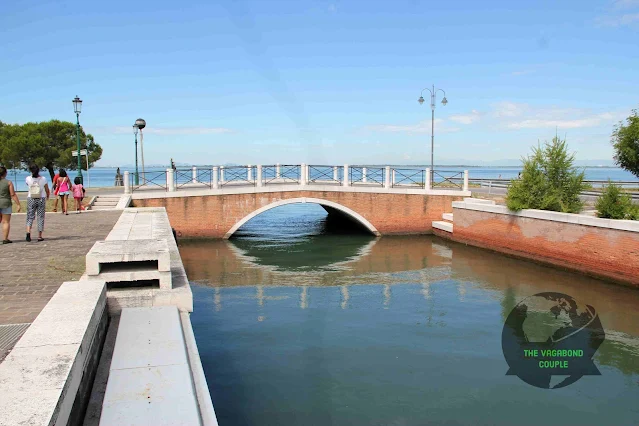 |
| Lido di Venezia |
Lido: A Taste of Venice, a Touch of Modernity
While Lido offers respite from the Venetian throngs, it doesn't lack Venetian soul. Sample fresh seafood in charming waterfront trattorias. Explore the vibrant Gran Viale Santa Maria Elisabetta, a bustling artery showcasing local shops and cafes. Discover the modern face of Lido at the Biennale Gardens, where contemporary art finds expression in verdant surrounds.
 |
| Lido di Venezia |
Beyond the Beach: Where History Walks on Sand
Explore the fascinating Jewish Cemetery, a silent witness to centuries of community and faith. Take a stroll through the Parco delle Rose, where vibrant blooms paint a fragrant masterpiece.
 |
| Lido di Venezia |
Festivals and Events: When Lido Shines Brightest
Lido explodes with life during its renowned festivals. Witness the glamour of the Venice Film Festival, where celebrities grace the red carpet under the starry Venetian sky. The Venice Biennale of Art transforms the island into a vibrant canvas, showcasing cutting-edge creativity.
Tips for experiencing Lido
- Rent a bike to explore the island's scenic paths.
- Visit the Venice Film Festival (September) or the Biennale (June-November) for a unique experience.
- Sample local cuisine, especially fresh seafood dishes.
- Take a vaporetto trip to the nearby islands of Burano and Murano.
- Relax and soak up the sun on the beach!
Piazzale Malamocco: Where the Lagoon Meets History
Nestled at the southern tip of Venice's Lido, Piazzale Malamocco is more than just a square; it's a gateway, a heartbeat and a microcosm of the Venetian lagoon's rich history. Here, the rhythm of the Adriatic Sea merges with the gentle pulse of the canals, weaving a tapestry of timeless charm.
 |
| Piazzale Malamocco, Lido di Venezia |
A Square Unlike Any Other
Unlike Venice's myriad "campi", Piazzale Malamocco proudly claims the title of "piazza", its trapezoidal shape standing out amidst the labyrinthine alleyways. This spacious piazza, nicknamed "la Piazza" or even "il salotto d'Europa," pulsates with life, serving as a meeting point for locals and visitors alike.
 |
| Piazzale Malamocco, Lido di Venezia |
Stepping Back in Time
A walk through Piazzale Malamocco is a journey through time. The Cippo porta pennone, a stone pillar bearing the names of victims of a WWII bombing, whispers of resilience. The Chiesa di San Pietro Martire (Church of Saint Peter Martyr), with its 15th-century bell tower, stands as a testament to faith. And the charming fishermen's houses, painted in vibrant hues, echo the maritime spirit that defines Malamocco.
 |
| Piazzale Malamocco, Lido di Venezia |
A Gastronomic Paradise
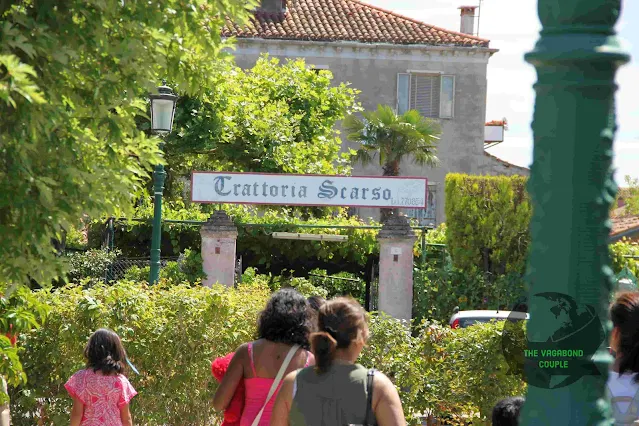 |
| A Venetian Restaurant at Piazzale Malamocco, Lido di Venezia |
Foodies rejoice! Piazzale Malamocco tantalizes taste buds with an array of culinary delights. From fresh seafood at Locanda da Scarso to traditional Venetian fare at Al Cavatappi, every bite is a celebration of regional flavors. Indulge in a glass of local wine while soaking in the piazza's vibrant atmosphere and let the taste of the lagoon linger on your palate.
Beyond the Piazza
Piazzale Malamocco is merely the first chapter in this enchanting story. Venture down the Fondamenta Malamocco, where colorful houses line the waterfront and watch gondolas glide by. Hop on a vaporetto, the waterbus and explore the hidden gems of the lagoon islands. Or simply bask on the sandy beaches, feeling the warm Venetian sun on your skin.
 |
| Piazzale Malamocco, Lido di Venezia |
Piazzale Malamocco: A Place to Linger
In the evenings, as the sun dips below the horizon, casting a golden glow across the piazza, the magic of Piazzale Malamocco truly comes alive. Streetlamps flicker to life, illuminating the timeless beauty of this historic square.
 |
| Sunset at Piazzale Malamocco, Lido di Venezia |
Whether you're seeking history, adventure, or simply a slice of Venetian life, Piazzale Malamocco offers an experience that lingers long after you leave.
 |
| Piazzale Malamocco, Lido di Venezia |
 |
| Chiesa di San Pietro Martire (Church of Saint Peter Martyr) Piazzale Malamocco, Lido di Venezia |
Tips for visiting Piazzale Malamocco
The best time to visit Piazzale Malamocco is during the spring or fall, when the weather is pleasant and the crowds are smaller.
- Wear comfortable shoes, as you'll be doing a lot of walking.
- Don't forget your camera!
- Be sure to try some of the local seafood dishes.
- Take a vaporetto ride to explore the lagoon islands.
- Relax and enjoy the atmosphere!
 |
| Piazzale Malamocco, Lido di Venezia |
From Piazzale Malamocco, we take a land bus to Piazzale Santa Maria Elisabetta.

 |
| Malamocco Centro / Riviera Giovanni Diacono Bus Stop (landbus, not vaporetto) |
Piazzale Santa Maria Elisabetta
Piazzale Santa Maria Elisabetta is the main square of Lido di Venezia. It is a bustling hub of activity, serving as a disembarkation point for ferries and buses from Venice and as a starting point for exploring the island's beaches and attractions.
 |
| Piazzale Santa Maria Elisabetta, Lido di Venezia |
The square is also home to the Chiesa di Santa Maria Elisabetta (Church of Santa Maria Elisabetta), a Baroque church dating from the 17th century.
 |
| Church of Santa Maria Elisabetta, Piazzale Santa Maria Elisabetta, Lido di Venezia |
The piazza is lined with shops, cafes and restaurants, making it a great place to people-watch or simply relax and enjoy the atmosphere. In the summer, the piazza comes alive with street performers, musicians and vendors selling souvenirs and snacks.
 |
| Piazzale Santa Maria Elisabetta, Lido di Venezia |
 |
| Piazzale Santa Maria Elisabetta seen from Lido ferry terminal (composite) |
 |
| Piazzale Santa Maria Elisabetta seen from Lido ferry terminal (Vaporetti stop), Lido di Venezia |
Lido S.M.E. ferry terminal
Piazzale Santa Maria Elisabetta is a great place to start a visit to the main island and its old town of Centro Storico, Venice. The elaborate Lido S.M.E. vaporetti terminal serves many ferry lines to the various islands of the Venetian lagoon.
 |
| Lido S.M.E. - Lido Santa Maria Elisabetta Ferry Terminal (Vaporetti Stop), Lido di Venezia |
The Lido SME ferry stop is served by several incoming vaporetto lines too, making it a convenient gateway to the Lido's beaches, casinos and other attractions.
 |
| Lido S.M.E. - Lido Santa Maria Elisabetta Ferry Terminal (Vaporetti Stop), Lido di Venezia |
Here are some additional details about the Lido SME ferry stop:
- Location: Fondamenta Santa Maria Elisabetta, Lido, Venice, Italy
- Services: Vaporetto lines 1, 5.1, 6, 10 and N
- Accessibility: The stop is accessible by foot and by boat. There are also public transportation options available, such as buses and water taxis.
- Amenities: The stop has ticket kiosks, waiting areas and restrooms. Some piers also have cafes and shops.
 |
| Lido S.M.E. ferry terminal, Piazzale Santa Maria Elisabetta, Lido di Venezia |
Lido SME consists of multiple piers, each designated by a letter: A, B, C, D and E. The specific pier you'll need depends on your vaporetto line and destination. For example, lines 1 and 6 typically use piers B and D, while lines 5.1 and 10 use piers A and E.

 |
| Lido S.M.E. ferry terminal, Piazzale Santa Maria Elisabetta, Lido di Venezia |
If you're planning to visit the Lido, I recommend checking the vaporetto schedules in advance to ensure you're using the correct pier. You can also purchase tickets online or, like us, at the kiosks at the stop.
On to San Marco, Venice aboard a Vaporetto from Lido
Imagine the gentle hum of the engine as you navigate the Venetian lagoon between historic islands, sunlight dancing on the water and ancient palazzos lining your path. Every bend reveals a new vista, gondolas swaying gracefully alongside and bridges adorned with intricate carvings overhead. The vaporetto offers a front-row seat to the Venetian spectacle, a moving postcard that unfolds with each stop.
 |
| Vaporetto from Lido to San Marco |
Beyond practicality, the vaporetto embodies the city's romantic spirit. As you stand on the open deck, the salty breeze kisses your face and the cries of the gulls mingle with the distant hum of voices. It's a scene straight out of a dream, a timeless experience that has captured the hearts of travelers for centuries.
 |
| Vaporetto from Lido to San Marco |
So, next time you find yourself in Venice, ditch the walking map and hop aboard a vaporetto. Let the gentle rhythm of the water lull you into a state of Venetian bliss and experience the city from a unique and unforgettable perspective.
Tempio Votivo della Pace di Venezia
The Tempio Votivo della Pace di Venezia is a votive church and military ossuary located on Lido island of Venice, Italy. It was built in the early 20th century as a memorial to the victims of the First World War.
 |
| Tempio Votivo della Pace di Venezia |
The church is designed in a neo-Romanesque style, with a large central dome and two smaller domes. The interior is decorated with mosaics and frescoes, depicting scenes from the Bible and the history of Venice.
The crypt of the church is a military ossuary, where the remains of over 3,000 soldiers who died in the First World War are buried. The ossuary is divided into two sections, one for Italian soldiers and one for soldiers from other countries.
Venice International University
The Venice International University, San Servolo, Venice, Italy (VIU) is a unique academic haven unlike any other. Picture an inspiring 16th-century monastery gracing the serene island of San Servolo, amidst the mesmerizing Venetian lagoon. This isn't just a picturesque backdrop; it's the beating heart of VIU, a vibrant consortium of 20 prestigious universities from around the globe.
 |
| Venice International University |
Step into VIU's ivy-clad walls and embark on an intellectual odyssey. Dive into interdisciplinary master's programs that tackle pressing global challenges, from sustainable futures to cultural heritage preservation. Engage in lively debates with classmates from diverse backgrounds, fueled by the university's commitment to intercultural dialogue.
 |
| Venice International University |
Beyond the classroom, VIU pulsates with life. Savor invigorating discussions in cozy cafes overlooking the Venetian expanse. Explore hidden gems in the city's labyrinthine streets, or lose yourself in the artistic treasures of nearby museums. Participate in workshops, conferences and cultural events, where minds mingle and ideas ignite.
Soon enough, we are about to enter the hallowed Grand Canal of Venice.
Basilica di Santa Maria della Salute
The Basilica di Santa Maria della Salute, also known simply as "La Salute," is a breathtaking Baroque church in Venice, Italy. It stands proudly at the entrance to the Grand Canal, its twin white domes and grand facade gleaming under the Venetian sun. Built in the 17th century as a votive offering to the Virgin Mary for saving the city from a devastating plague, La Salute is a symbol of both faith and resilience.
 |
| Basilica di Santa Maria della Salute |
The Basilica's octagonal design, adorned with intricate sculptures and statues, is a masterpiece of Baroque architecture. Its two domes, one large and one smaller, represent the crowns of the Virgin Mary and Christ, respectively. Inside, the church is richly decorated with paintings by renowned Venetian artists like Titian and Tintoretto, adding to its awe-inspiring atmosphere.
 |
| Basilica di Santa Maria della Salute |
La Salute is not just a beautiful church; it's a vital part of Venetian history and culture. Every year on November 21st, the city celebrates the "Festa della Salute" with a grand procession across the Grand Canal, culminating in a mass at the Basilica. This tradition is a testament to the enduring gratitude of the Venetian people for their deliverance from the plague.
Church of San Giorgio Maggiore
Bathed in the glow of the sun, the Church of San Giorgio Maggiore rises like a radiant vision from the emerald waters of the lagoon. Designed by the legendary architect Andrea Palladio, its gleaming white marble facade, adorned with graceful columns and harmonious arches, embodies the elegance of Renaissance architecture.
 |
| Church of San Giorgio Maggiore |
Standing sentinel on its own island, San Giorgio Maggiore offers breathtaking panoramas of the Venetian skyline. From its bell tower, the city unfolds like a tapestry of terracotta roofs and shimmering canals, with iconic landmarks like St. Mark's Basilica and the Doge's Palace dancing on the horizon.
 |
| The Last Supper by Jacopo Tintoretto |
Step inside the church and prepare to be awestruck. Bathed in a soft, ethereal light filtering through arched windows, the vast interior exudes an air of tranquility. Tintoretto's monumental masterpieces adorn the walls, each stroke radiating the drama and emotion of biblical scenes. From the Last Supper's poignant intimacy to the Fall of Manna's celestial grandeur, these paintings transport you to another realm.
Doge's Palace
The Doge's Palace, a majestic blend of Venetian Gothic and Byzantine architecture, reigns supreme in Venice's Piazza San Marco. Imagine a vision carved from alabaster and rose-hued stone, its delicate arcades adorned with intricate tracery and sculpted figures. This, my friend, is the embodiment of Venetian power and artistry.
 |
| Doge's Palace |
Step beneath the Porta della Carta, its gilded Gothic arch boasting scenes of Venetian conquest and enter a world of opulent chambers and dramatic passages. The Giants' Staircase, flanked by colossal statues of mythological heroes, leads you to the vast Sala del Maggior Consiglio, where the Venetian senate once convened. Gaze up at the awe-inspiring ceiling, a wooden tapestry painted with scenes of Venetian glory.
 |
| Doge's Palace |
Wander through the Sala delle Quattro Porte, its walls adorned with masterpieces by Tintoretto and Veronese, depicting Venice's triumphs and allegories of justice. Brace yourself for the Bridge of Sighs, a white stone passage linking the palace to the dank prisons, its name whispered by countless souls who crossed its threshold.
 |
| Doge's Palace |
The Doge's Palace is more than a museum; it's a portal to Venice's vibrant past. Its every corner whispers tales of doges, conspiracies and triumphs, promising an unforgettable journey through the heart of the Venetian Republic.
We get off our vaporetto at the S. Marco ferry terminal and walk into Piazza San Marco (St Mark's Square) which is the iconic main public square of Venice surrounded by its most famous buildings including the St Mark's Basilica and Doge's Palace.
Piazza San Marco: The Heartbeat of Venice's Timeless Grandeur
“The world's most beautiful drawing room, ” said Napoleon about the beating heart of Venice. It thrums with a timeless melody.
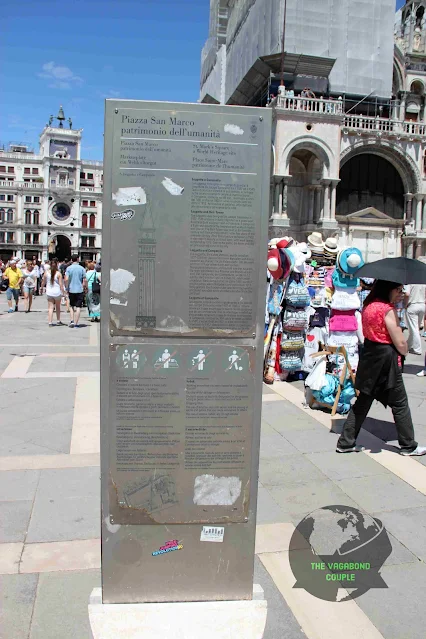 |
| Piazza San Marco |
Picture this: a vast expanse of polished stone, flanked by architectural masterpieces bathed in the warm glow of the Italian sun.
 |
| Piazza San Marco (St. Mark's Square), Venice, Italy (composite) |
To the north, the awe-inspiring Basilica di San Marco, its gilded mosaics shimmering like a celestial mosaic, beckons the eye. Across the piazza, the grand Doge's Palace, a testament to Venetian power and artistry, stands in stoic splendor.
 |
| Saint Mark's Basilica |
But Piazza San Marco is more than just a museum of grand buildings. It's a stage where life unfolds in a vibrant spectacle. Imagine pigeons dancing across the piazza, their cooing mingling with the lively chatter of locals and the joyful laughter of children chasing bubbles. Elegant cafes spill out onto the square, their tables adorned with colorful umbrellas, inviting you to linger over a steaming cappuccino and soak in the atmosphere. String trios serena the air, their melodies competing with the gentle lap of the lagoon against the quay.
 |
| Piazza San Marco / St. Mark's Square |
As the sun dips low, casting long shadows across the piazza, a hush falls. Gondolas, sleek and black, glide silently through the canals, their gondoliers singing traditional Venetian songs that echo centuries of history.
 |
| Piazza San Marco / St. Mark's Square |
In the twilight, the city takes on a magical air, the piazza becoming a stage for dreams and whispered secrets.
 |
| Piazza San Marco / St. Mark's Square |
Piazza San Marco is a place where time seems to stand still, where the past whispers in every corner and the present unfolds in a captivating panorama.
 |
| Piazza San Marco / St. Mark's Square |
It's a place to wander, to savor, to soak in the essence of Venice at its most vibrant and alive. So, come, lose yourself in the symphony of sights and sounds and let Piazza San Marco weave its magic on your soul.
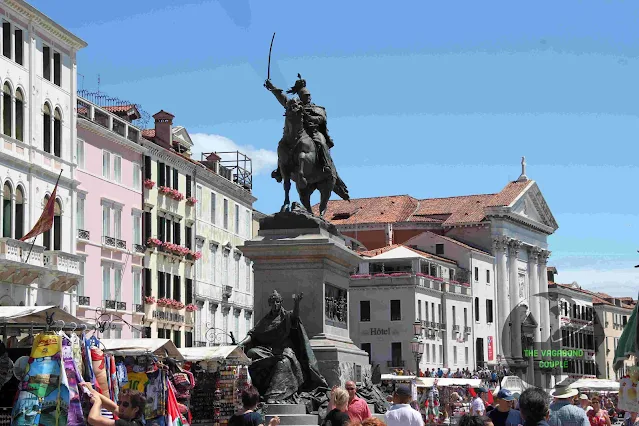 |
| Piazza San Marco / St. Mark's Square |
Venice, the floating city of romance and mystique, is adorned with architectural marvels and cultural treasures that captivate the imagination. At the center of this enchanting city lies Piazza San Marco, a square that serves as a testament to Venice's rich history, artistic brilliance and enduring allure.
 |
| Piazza San Marco / St. Mark's Square |
As the principal public square of the city, Piazza San Marco has been a hub of activity and a symbol of Venetian grandeur for centuries.
 |
| Piazza San Marco / St. Mark's Square |
Piazza San Marco, also known as St. Mark's Square, has been at the heart of Venetian life since the 9th century. Named after the patron saint of Venice, St. Mark, the square has witnessed the rise and fall of empires, hosted countless celebrations and borne witness to the ebb and flow of Venetian society.
 |
| Piazza San Marco / St. Mark's Square |
The square has served various functions throughout its history, from a gathering place for local markets to a venue for grand festivities. However, its most iconic role has been as the political and religious center of the Venetian Republic.
 |
| Piazza San Marco / St. Mark's Square |
The magnificent St. Mark's Basilica, a masterpiece of Byzantine architecture, stands proudly at one end of the square, serving as a symbol of Venetian power and piety.
 |
| Piazza San Marco / St. Mark's Square |
Piazza San Marco is surrounded by architectural wonders that reflect a harmonious blend of Byzantine, Gothic and Renaissance styles. The iconic Campanile, a towering bell tower that offers panoramic views of Venice, stands tall on one side of the square.
 |
| St Mark's Campanile (composite) |
 |
| Piazza San Marco / St. Mark's Square |
The Procuratie Vecchie and Procuratie Nuove, two arcaded buildings flanking the square, add a touch of elegance and serve as a reminder of Venice's commercial prosperity during the Renaissance.
 |
| Piazza San Marco / St. Mark's Square |
The Doge's Palace, an architectural gem adjoining the square, was the residence of the Doge, the chief magistrate and leader of the Venetian Republic. With its intricate facades and opulent interiors, the palace is a testament to the wealth and power of Venice during its heyday.
 |
| Piazza San Marco / St. Mark's Square |
Piazza San Marco has long been a cultural hub, attracting artists, writers and thinkers from around the world.
 |
| Piazza San Marco / St. Mark's Square |
The open-air cafes that line the square provide the perfect vantage point for people-watching and immersing oneself in the vibrant atmosphere.
 |
| Piazza San Marco / St. Mark's Square |
Visitors can enjoy a leisurely coffee while listening to the melodies of street musicians or savoring the views of the iconic architecture.
 |
| Piazza San Marco / St. Mark's Square |
The square also hosts various events throughout the year, from the traditional Venetian Carnival to outdoor concerts and art exhibitions. These festivities contribute to the lively and dynamic spirit of Piazza San Marco, making it not just a historical site but a living, breathing part of Venetian culture.
 |
| Piazza San Marco / St. Mark's Square |
Piazza San Marco has been a witness to Venetian traditions that have stood the test of time. The annual ceremony of the Sensa, or the Marriage of the Sea, is celebrated in the square, symbolizing the maritime dominion of Venice.
 |
| Piazza San Marco / St. Mark's Square |
Additionally, the tradition of feeding the city's pigeons, though controversial in recent years due to concerns about hygiene and damage to monuments, remains a nostalgic and iconic image associated with the square.
 |
| Piazza San Marco / St. Mark's Square |
We then embark on the mandatory Venetian activity of a Gondola ride that is woven into the city's history, culture and aesthetic.
A Gondola Journey Through Venice's Liquid Streets: A Romantic Odyssey
 |
| Gondola stand at Piazza San Marco |
Venice, with its maze of waterways and enchanting architecture, is a city unlike any other. One of the quintessential experiences that beckons visitors to this floating wonder is a ride on a gondola.
 |
| Boarding a gondola at Piazza San Marco |
Gliding through the serene canals aboard these elegant black boats offers a unique perspective of Venice, revealing the city's romantic charm and timeless beauty.
 |
| Boarding a gondola at St. Mark's Square |
The gondola, a sleek and slender boat, is an iconic symbol of Venice. Steeped in history and tradition, these handcrafted vessels are synonymous with the city's romantic allure.
 |
| Gondola ride from Piazza San Marco stand |
The classic black hue, ornate detailing and the iconic forcola (a unique oarlock) all contribute to the gondola's unmistakable charm.
 |
| Sailing the canals of Venice on a gondola |
Historically, gondolas were the primary mode of transportation for Venetians navigating the intricate network of canals and today, they continue to evoke a sense of old-world glamour.
 |
| Sailing the canals of Venice on a gondola |
The journey begins at one of the many gondola stations scattered throughout Venice. We began our ride at the St. Mark's Square gondola station.
 |
| Sailing the waterways of Venice on a gondola |
As you step into the boat and settle onto plush cushions, the gondolier, often dressed in traditional attire, takes control of the iconic single oar, expertly guiding the vessel through the labyrinthine waterways.
 |
| Venetian building water entrance seen from gondola on canal |
As the gondola glides through the narrow canals, the rhythmic sound of the oar dipping into the water creates a melodic symphony that echoes off the ancient buildings.
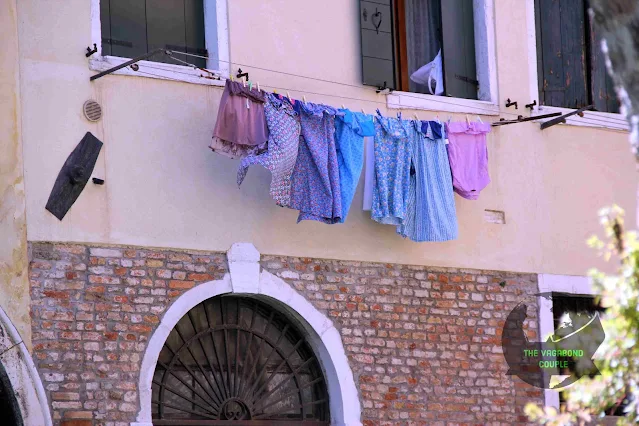 |
| Clothes hung out for drying from waterway residences on Venice canals |
The slow, deliberate movements of the gondolier seem to dance with the gentle ripples of the water, offering a serene and captivating experience.
 |
| Sailing on waterways under bridges over canals in Venice |
The intimate size of the gondola allows for a more personal connection with the city's architecture, as you pass beneath picturesque bridges and alongside historic buildings.
 |
| Sailing the canals of Venice on a gondola |
Riding a gondola provides a unique vantage point to admire the architectural wonders that line the canals.
 |
| Sailing the canals of Venice on a gondola |
From the opulent facades of palaces to the charming simplicity of residential buildings, each structure tells a story of Venice's rich history and cultural heritage.
 |
| Another building entrance on the waterway on a canal in Venice |
The experience is particularly enchanting during the golden hour, as the warm hues of the setting sun cast a magical glow over the city, turning the canals into liquid gold.
 |
| Sailing the canals of Venice on a gondola |
A gondola ride is often associated with romance and it's easy to understand why. The tranquil ambiance, the soothing sounds of water lapping against the boat and the intimate setting create a perfect backdrop for couples.
 |
| Yet another building's entrance on the waterways of Venice |
Whether you're sharing a quiet moment with a loved one or simply reveling in the solitude of the journey, the gondola ride is a romantic escapade that etches lasting memories.
 |
| Sailing the canals of Venice on a gondola |
The Venetian gondola is an instantly recognizable icon, gracing the canals of Venice for centuries. Its unique characteristics go beyond aesthetics, serving practical purposes and embodying rich cultural heritage.
 |
| Sailing the canals of Venice on a gondola |
Here are some characteristics of a Venetian Gondola that make them special:
1. Asymmetric Design of Venetian Gondola:
Gondolas are not perfectly symmetrical. The right side is wider and higher than the left, to compensate for the gondolier's weight standing on the left side.
 |
| Asymmetric design of gondolas in Venice: gondolier stands on left, gondola is wider on the right |
This asymmetry also aids in turning and maneuvering through narrow canals.
2. Flat Bottom of Gondolas in Venice:
The gondola's flat bottom allows it to navigate the shallow waters of the Venetian lagoon, where the depth can vary greatly.
 |
| Flat bottom of the gondola behind us |
This makes it ideal for traversing the city's intricate network of canals.
3. Single Oar Propulsion of Gondola in Venice:
Gondolas are propelled by a single oar wielded by the gondolier, who stands at the stern.
 |
| Single Oar Propulsion of Gondola |
The oarlock (forcola) is uniquely shaped to allow for various movements, including forward rowing, turning and stopping.
4. Ornamental Prows of Gondolas of Venice:
The ornate "ferro da prova" at the front of the gondola is more than just decoration.
 |
| "ferro da prova" decoration in front of the green gondola next to us |
Its S-shape symbolizes the Grand Canal and its six prongs represent the city's six sestieri (districts).
5. Handmade Construction of Gondola in Venice:
Each gondola is a work of art, handcrafted from 280 pieces of eight different types of wood.
 |
| Decorations on Gondola |
The construction process takes months and skilled artisans pass down their knowledge through generations.
6. Cultural Significance of Gondolas of Venice:
The gondola is more than just a means of transportation; it's a symbol of Venice itself.
 |
| Sailing the canals of Venice on a gondola |
The Venetian gondola has been featured in countless works of art and literature and its gliding presence continues to enchant visitors from around the world.
 |
| Gondola Ride in Venice |
These are just some of the defining characteristics of the Venetian gondola. Its unique design, functionality and cultural significance make it a true masterpiece of human ingenuity and a treasured part of Venetian heritage.
Murano's Glass Factories: A Legacy of Artistry and Craftsmanship in Venice
Nestled in the Venetian Lagoon just a short boat ride from Venice, the island of Murano has been synonymous with exquisite glass craftsmanship for centuries. Renowned worldwide for its intricate glasswork, Murano is home to a rich tradition of glassmaking that dates back to the 13th century.
 |
| Murano Lighthouse |
The island's glass factories stand as living monuments to the artistry and craftsmanship that have made Murano an international center for glass production.
 |
| Promenade at Murano |
The history of Murano's glassmaking can be traced back to 1291 when the Venetian Republic ordered the relocation of glassmakers to the island to prevent the risk of fire in the densely populated city of Venice.
 |
| Promenade at Murano |
This strategic move not only protected the city but also laid the foundation for Murano's emergence as a hub for glass production. Over the centuries, Murano glassmakers honed their skills, developing techniques that remain unparalleled to this day.
 |
| Murano Navagero Waterbus Stop |
 |
| Promenade at Murano |
One of the most distinctive features of Murano glass is the island's mastery of various glassmaking techniques. Murano artisans are adept at creating a wide range of glass products using methods such as lampworking, glass blowing and glass fusion.
 |
| A glass factory in Murano |
These techniques allow for the creation of intricate glass sculptures, chandeliers, vases and an array of decorative items that showcase the diversity and versatility of Murano glass.
 |
| A Murano glass factory |
At the heart of Murano's glassmaking tradition are the skilled artisans who dedicate their lives to perfecting their craft. These artisans, often belonging to long-standing glassmaking families, undergo rigorous training to master the delicate and complex techniques required for creating Murano glass masterpieces. Their expertise is passed down from generation to generation, preserving the island's unique artistic legacy.
 |
| A glass artisan demonstrating traditional glassmaking |
Murano boasts a plethora of glass factories, each with its own distinctive style and specialties. These factories serve as both workshops and galleries, allowing visitors to witness the mesmerizing process of glass creation while also exploring the finished products on display. Some renowned glass factories on the island include Venini, Barovier & Toso and Seguso, all of which contribute to the island's reputation for producing world-class glass art.
 |
| A glass factory in Murano |
While Murano's glassmaking tradition is deeply rooted in history, it has not remained stagnant. The island's glass factories have embraced innovation while preserving traditional techniques, blending the old with the new. Contemporary artists collaborate with master artisans to push the boundaries of Murano glass, creating modern designs that continue to captivate a global audience.
 |
| A glass factory in Murano |
Murano's glass factories are a major draw for tourists seeking an authentic and immersive experience. Visitors can tour the workshops, witnessing the artistry firsthand and gaining insights into the meticulous process of glassmaking.
 |
| A glass factory store in Murano |
Many factories also offer workshops, allowing enthusiasts to try their hand at crafting their own glass pieces under the guidance of experienced artisans.
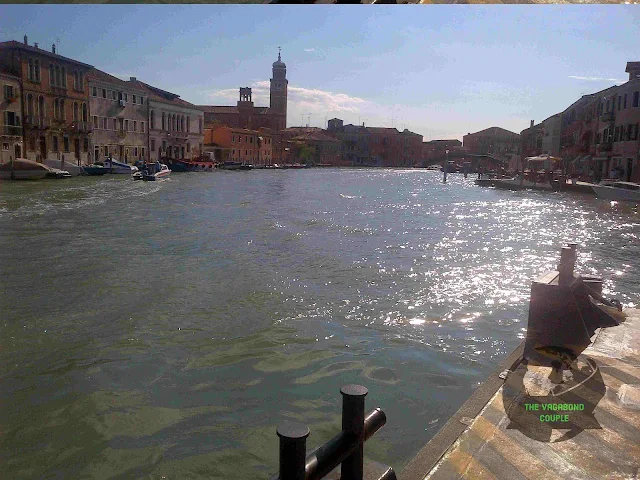 |
| Murano |
San Michele in Isola
On our way back from Murano to Venice, we sail by the small island of San Michele between the islands of Venice and Murano in the Venetian Lagoon. The San Michele in Isola is situated on this small island holding a unique and contemplative charm in the island-city complex of Venice.
 |
| San Michele in Isola, Isola di San Michele |
This historic island, once a Camaldolese monastery, was repurposed in the 19th century as the main cemetery for the city. San Michele's tranquil and ornate church, designed by Mauro Codussi in the 15th century, welcomes visitors with its elegant facade and serene interior. The island is renowned for its beautifully landscaped cemetery, where the final resting places of many notable figures, including poets, artists and musicians, are adorned with elaborately crafted tombstones and sculptures.
 |
| San Michele in Isola, Isola di San Michele |
The atmosphere on San Michele is one of quiet reflection, offering a respite from the lively canals and bustling streets of Venice. The island's artistic and historical significance, combined with its tranquil ambiance, makes San Michele in Isola a poignant and culturally rich destination for those seeking a glimpse into Venice's past.
Cimitero San Michele
Cimitero San Michele, also located on the island of San Michele in the Venetian Lagoon, is a remarkable and evocative cemetery that stands as a testament to Venice's unique approach to memorializing the departed. Established in the early 19th century, this cemetery replaced the crowded graveyards on the main islands of Venice, providing a dignified and scenic resting place for the deceased.
 |
| Cimitero San Michele waterbus stop |
As one navigates the network of pathways adorned with cypress trees and sculptures, the cemetery unfolds as a historical tapestry, with the final resting places of luminaries such as Igor Stravinsky, Joseph Brodsky and Ezra Pound. The graves themselves are often adorned with elaborate and artistic tombstones, reflecting the cultural richness and artistic heritage of the city. Cimitero San Michele, with its serene ambiance and poignant historical connections, offers visitors a unique perspective on the intersection of art, history and mortality in the heart of the Venetian archipelago.
We disembark the waterbus at San Zaccaria / San Marco and find ourselves again at Riva degli Schiavoni.
 |
| San Zaccaria waterbus station |
Monument to Victor Emmanuel II: "The Monument" of Venice
Standing proudly on the Riva degli Schiavoni in Venice, the Monument to Victor Emmanuel II (simply "the monument" to Venetians) is a striking equestrian statue honoring the first king of a unified Italy. Created by Roman sculptor Ettore Ferrari in 1887, the monument commemorates the 10th anniversary of Victor Emmanuel II's death. Its construction sparked controversy, as some Venetians resented the annexation of their historic republic by the Kingdom of Italy under Victor Emmanuel II in 1866.
The centerpiece is a bronze statue of Victor Emmanuel II on horseback, sword drawn, seemingly urging his troops forward.
 |
| Monument to Victor Emmanuel II |
The base features two allegorical figures flanking the monument:
Venice Redeemed: Depicted as a triumphant winged lion on top of a closed book, symbolizing Venice's liberation from Austrian rule.
 |
| Venice Redeemed, Monument to Victor Emmanuel II |
Subjugated Venice: A seated woman with a broken sword and a lion gnawing on chains, representing the city's struggle during Austrian rule.
 |
| Subjugated Venice, Monument to Victor Emmanuel II |
Things to Look Out For:
- The intricate details of the bronze statue, from the king's armor to the horse's muscles.
- The symbolism of the lions, wings, and broken chains, adding layers of meaning to the monument.
- The stunning views of the Venetian lagoon and the Riva degli Schiavoni from the base of the monument.
The monument is easily accessible on foot or by vaporetto (water bus) from any point in Venice. There's no entrance fee, making it a free and easy way to learn about Venetian history and admire the artistry.
A Venetian Lagoon Sunset: Captivating Canvas of Colors
We catch the stunning Venetian sunset as we sail another waterbus back to Lido as the golden sun dips below the horizon casting its warm hues across the iconic city of Venice and its surrounding lagoon. A breathtaking spectacle unfolds - the Venetian Lagoon sunset.
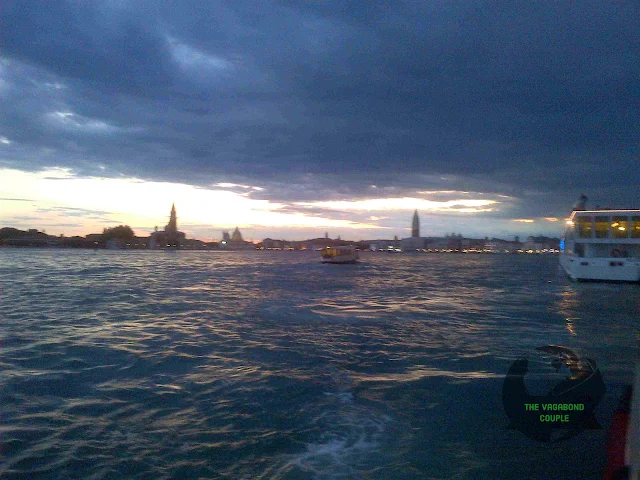 |
| Sunset in Venice |
Beyond the enchanting canals and historic buildings, the lagoon transforms into a mesmerizing canvas, painting the sky with a palette of vivid colors. This daily performance is a testament to the city's timeless allure, where nature and architecture harmonize to create a truly unforgettable experience.
 |
| Sunset in Venice |
As the day wanes, the Venetian Lagoon becomes a theater for the dance of colors. The sky transitions from a brilliant blue to warm shades of orange, pink and purple, reflecting off the water and casting an ethereal glow upon the city's historic landmarks. The silhouettes of gondolas and vaporettos add to the romantic ambiance, creating a scene straight from a Venetian masterpiece.
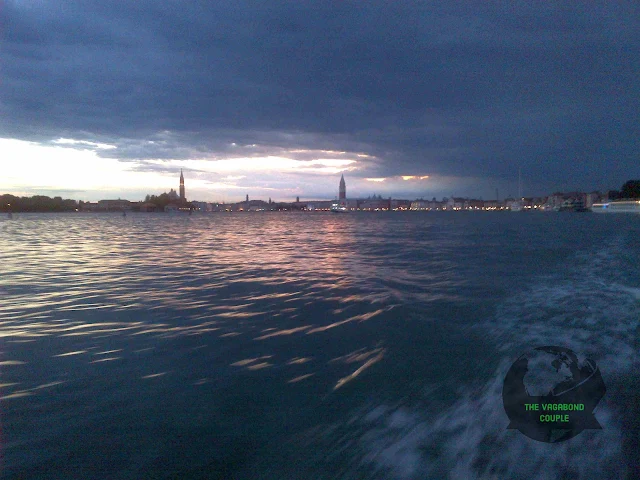 |
| Sunset in Venice |
The sunset casts a magical spell on Venice's renowned landmarks, transforming them into silhouettes against the vibrant backdrop of the lagoon. The domes of St. Mark's Basilica and the graceful curves of the Rialto Bridge take on an otherworldly beauty, capturing the essence of a city that seamlessly blends history, architecture and natural beauty.
 |
| Sunset in Venice |
As the sun sinks lower, the Grand Canal becomes a liquid ribbon of gold, reflecting the fading light and the facades of the elegant palazzos that line its banks. The gentle ripples of passing boats create a shimmering effect, adding to the visual poetry of the moment. Locals and visitors alike often gather along the canal's edge or on bridges to savor this nightly spectacle.
 |
| Sunset in Venice |
The Venetian Lagoon sunset offers more than just a feast for the eyes; it provides a moment of quiet contemplation. As the city gradually quiets down, the gentle lapping of the water against the docks creates a serene soundtrack. The fading light encourages reflection, allowing visitors to immerse themselves in the timeless beauty of the lagoon and its surroundings.
 |
| Sunset in Venice |
For those seeking a more intimate experience, a sunset gondola ride is a quintessential Venetian experience. Drifting along the canals, under arched bridges and past centuries-old buildings, the soft glow of the setting sun casts a romantic spell on the couples and friends sharing these iconic vessels.
 |
| Sunset in Venice |
The sunset on the Venetian Lagoon is not merely a fleeting moment but a daily masterpiece that showcases the city's unique blend of natural beauty and architectural splendor. Whether experienced from the shores, the bridges, or the deck of a gondola, the Venetian Lagoon sunset is a poetic reminder of why Venice continues to captivate the hearts of those fortunate enough to witness its daily transformation into a living work of art.
On to Rome
The next morning, we return to the main island and check back in to the Venezia Santa Lucia railway station. We bid adieu to Venice and take a Trenitalia Frecciarossa fast train to Rome. When it comes to traveling from Venice to Rome in a flash, the high-speed trains are the champions.
 |
| Trenitalia Frecciarossa |
Frecciarossa by Trenitalia - the sleek red arrows - are the ultimate speed demons, zipping between the two cities in under four hours. They whisk us through the Italian countryside at up to 190 mph offering comfort, style and stunning views. The story of this visit to Rome is at <TBD>.
Note: Prose in this post received AI assistance from ChatGPT and Bard.





































0 comments